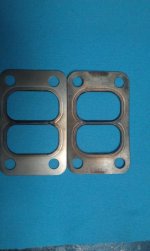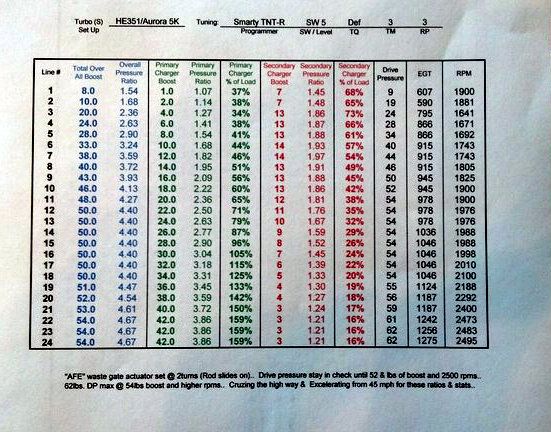Extended Power
New member
- Joined
- May 19, 2006
- Messages
- 2,978
Lots of stuff happening now...
Everything is pulled off to be ceramic coated. (Loosing over 400*F from manifold to primary turbo on easy acceleration.)
-I have port matched the new .80A/R housing for the 68mm turbine wheel, and opened up the wastegate ports to 5/8")
-I have port matched the .80A/R housing for the 73mm turbine wheel...left the gates as-is...they are already oversized from Industrial Injection.
-I have port matched the .70A/R housing to the bigger T3 manifold gasket I have. The .70 housing was port matched already, but the new gaskets I found are bigger yet. The waste gate ports are opened up from before.
-Primary housing is being coated in high lustre, and all three T3 housings are being ceramic coated with the "Titanium" coating (Rated at 2000+*F). (Inside and out)
-Hotpipe is being ceramic coated in high lustre. (inside and out)
-Primary turbo mounting bracket is being ceramic coated in high lustre, as it has the elbow and v-band connection on it.
-Ordered turbo blankets from Levi for the T3 and T6 housings.
-Drilled and tapped another 1/8" female npt port into the elbow just before the primaries inlet flange so I can watch the temperature and the pressure at the same time, and not just one or the other.
-Purchased a new 40mm JGS wastegate from a fellow member here.
-During the winter, I will fab up the gate to my system, and have it set to open around the 45psi rising mark, and dump into the hotpipe.
-Heres a couple pictures of the bigger T3 gasket.
Everything is pulled off to be ceramic coated. (Loosing over 400*F from manifold to primary turbo on easy acceleration.)
-I have port matched the new .80A/R housing for the 68mm turbine wheel, and opened up the wastegate ports to 5/8")
-I have port matched the .80A/R housing for the 73mm turbine wheel...left the gates as-is...they are already oversized from Industrial Injection.
-I have port matched the .70A/R housing to the bigger T3 manifold gasket I have. The .70 housing was port matched already, but the new gaskets I found are bigger yet. The waste gate ports are opened up from before.
-Primary housing is being coated in high lustre, and all three T3 housings are being ceramic coated with the "Titanium" coating (Rated at 2000+*F). (Inside and out)
-Hotpipe is being ceramic coated in high lustre. (inside and out)
-Primary turbo mounting bracket is being ceramic coated in high lustre, as it has the elbow and v-band connection on it.
-Ordered turbo blankets from Levi for the T3 and T6 housings.
-Drilled and tapped another 1/8" female npt port into the elbow just before the primaries inlet flange so I can watch the temperature and the pressure at the same time, and not just one or the other.
-Purchased a new 40mm JGS wastegate from a fellow member here.
-During the winter, I will fab up the gate to my system, and have it set to open around the 45psi rising mark, and dump into the hotpipe.
-Heres a couple pictures of the bigger T3 gasket.



